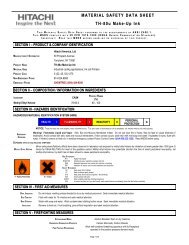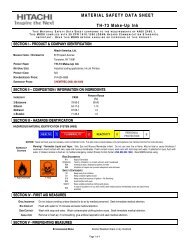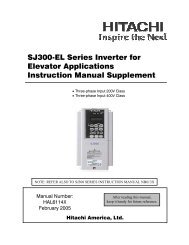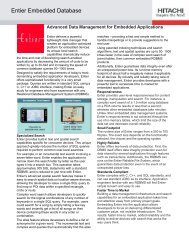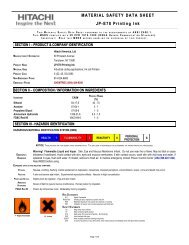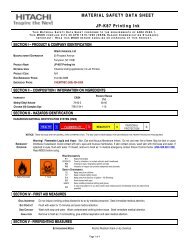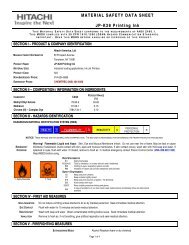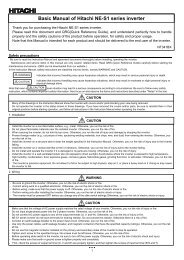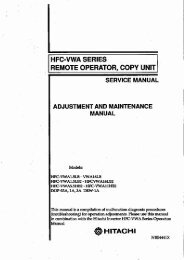SJ700-2 Instruction Manual NT204DX - Hitachi America, Ltd.
SJ700-2 Instruction Manual NT204DX - Hitachi America, Ltd.
SJ700-2 Instruction Manual NT204DX - Hitachi America, Ltd.
Create successful ePaper yourself
Turn your PDF publications into a flip-book with our unique Google optimized e-Paper software.
Chapter 5 Error Codes<br />
Name<br />
Undervoltage<br />
CT error<br />
CPU error<br />
(*3)<br />
External trip<br />
USP error<br />
Ground-fault<br />
protection<br />
(*3)<br />
Input<br />
overvoltage<br />
protection<br />
Instantaneous<br />
power<br />
failure<br />
protection<br />
Temperature<br />
error due to<br />
low<br />
cooling-fan<br />
speed<br />
Temperature<br />
error<br />
Description<br />
If the inverter input voltage drops, the<br />
control circuit of the inverter cannot<br />
function normally. Therefore, the inverter<br />
shuts off its output when the input<br />
voltage falls below a specified level.<br />
The inverter will trip if the DC voltage<br />
across the P and N terminals exceeds<br />
about 175 VDC (in case of the 200 V<br />
class models) or about 345 VDC (in case<br />
of the 400 V class models).<br />
If an error occurs in the internal current<br />
detector (CT), the inverter will shut off its<br />
output and display the error code shown<br />
on the right. The inverter will trip when<br />
the CT outputs about 0.6 V or more at<br />
power-on.<br />
If the internal CPU malfunctions or an<br />
error occurs in it, the inverter will shut off<br />
its output and display the error code<br />
shown on the right.<br />
Note: Reading an abnormal data from<br />
the EEPROM may result in a CPU error.<br />
If an error occurs in the external<br />
equipment or device connected to the<br />
inverter, the inverter will fetch the error<br />
signal and shut off its output. (This<br />
protective function is enabled when the<br />
external trip function is enabled.)<br />
A USP error is indicated when the<br />
inverter power is turned on with an input<br />
operation signal remaining in the<br />
inverter. (This protective function is<br />
enabled when the USP function is<br />
enabled.)<br />
When the inverter power is turned on,<br />
this protective function detects the<br />
ground fault between the inverter output<br />
circuit and the motor to protect the<br />
inverter. (This function does not operate<br />
when a residual voltage remains in the<br />
motor.)<br />
This protective function determines an<br />
error if the input voltage is kept above<br />
the specification level for 100 seconds<br />
while the inverter is stopped.<br />
The inverter will trip if the DC voltage of<br />
the main circuit is kept above about 390<br />
VDC (in case of the 200 V class models)<br />
or about 780 VDC (in case of the 400 V<br />
class models).<br />
If an instantaneous power failure lasts 15<br />
ms or more, the inverter will shut off its<br />
output.<br />
When the power failure duration is long,<br />
the inverter assumes a normal power-off.<br />
If a restart mode has been selected and<br />
an operation command remains in the<br />
inverter, the inverter will restart after the<br />
power is recovered.<br />
The inverter will display the error code<br />
shown on the right if the lowering of<br />
cooling-fan speed is detected at the<br />
occurrence of the temperature error<br />
described below.<br />
If the main circuit temperature rises<br />
because of a high ambient temperature<br />
or for other reasons, the inverter will shut<br />
off its output.<br />
Display on<br />
digital operator<br />
Display on<br />
remote operator<br />
Under.V<br />
CT<br />
CPU<br />
EXTERNAL<br />
USP<br />
GND.Flt<br />
OV.SRC<br />
Inst.P-F<br />
OH.stFAN<br />
OH.fin<br />
Troubleshooting and corrective action<br />
Check whether the power supply voltage has<br />
dropped.<br />
(Check the power supply.)<br />
Check whether the power supply capacity is<br />
sufficient.<br />
(Check the power supply.)<br />
Check whether the thyristor has been damaged.<br />
(Check the thyristor.)<br />
Check whether the inverter has failed.<br />
(Repair the inverter.)<br />
Check for the noise sources located near the<br />
inverter.<br />
(Remove noise sources.)<br />
Check whether the inverter has failed.<br />
(Repair the inverter.)<br />
Check whether an error has occurred in the<br />
external equipment (when the external trip<br />
function has been enabled).<br />
(Recover the external equipment from the error.)<br />
Referen<br />
ce page<br />
4-25<br />
-<br />
-<br />
4-56<br />
Check whether the inverter power has been<br />
turned on with an input operation signal remaining<br />
in the inverter (when the USP function has been<br />
4-55<br />
enabled).<br />
(Reset the operation command, and then turn on<br />
the inverter power.)<br />
Check for the ground fault.<br />
(Check the output cables and motor.)<br />
Check the inverter itself for abnormality.<br />
(Remove the output cables from the inverter, and<br />
-<br />
then check the inverter.)<br />
Check the main circuit for abnormality.<br />
(Check the main circuit with reference to<br />
Chapter 6.) (Repair the inverter.)<br />
Check whether the input voltage is high while the<br />
inverter is stopped.<br />
(Lower the input voltage, suppress the power<br />
voltage fluctuation, or connect an AC reactor<br />
between the power supply and the inverter input.) -<br />
Check whether the power supply voltage has<br />
dropped.<br />
(Recover the power supply.)<br />
Check the MCB and magnetic contactors for poor<br />
contacts.<br />
(Replace the MCB and the magnetic contactor.)<br />
Check whether the cooling efficiency has been<br />
lowered.<br />
(Replace the cooling fan.)<br />
Check the heat sink for clogging.<br />
(Clean the heat sink.)<br />
Check whether the inverter is installed vertically.<br />
(Check the installation.)<br />
Check whether the ambient temperature is high.<br />
(Lower the ambient temperature.)<br />
*3 The inverter will not accept reset commands input via the RS terminal or entered by the STOP/RESET key. Therefore, turn off the<br />
inverter power.<br />
4-34<br />
-<br />
-<br />
5 - 2




